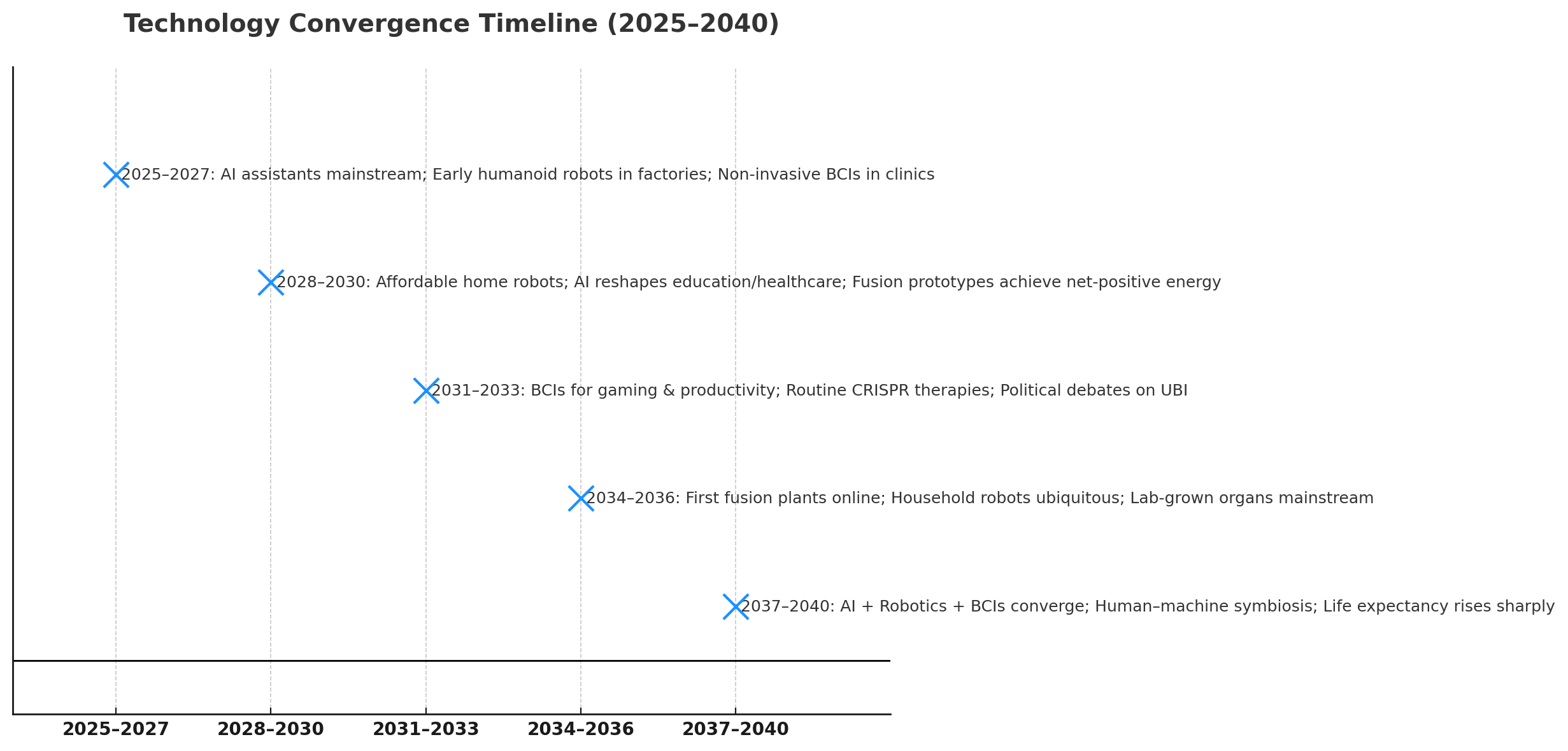07:33:21 am 08/18/2025
Viewed: 4533
The Next Life-Changing Technology: A Convergence of AI, Robotics, and Human Augmentation
History teaches us that transformative technologies rarely arrive in isolation. The printing press, the steam engine, electricity, and the internet all reshaped civilization not only through their invention but through their integration into human life. Today, we stand at another threshold: the convergence of artificial intelligence, robotics, brain–computer interfaces, clean energy, and biotechnology.
This is not speculative science fiction. The pieces are already here. What remains is the refinement, scaling, and—most importantly—the human willingness to adopt.
Artificial Intelligence + Embodied Robots
Large language models like GPT-4 and GPT-5, DeepMind’s Gemini, and Anthropic’s Claude already demonstrate reasoning, dialogue, and code generation. Yet their true world-shaping potential will be realized when AI steps beyond the screen and into physical space.
Companies such as Tesla (Optimus), Boston Dynamics, and Sanctuary AI are developing humanoid and task-specific robots, aiming for machines that can cook, clean, deliver packages, or even provide eldercare.
Ray Kurzweil, famed futurist, predicted in The Singularity is Near (2005) that by the 2030s, artificial general intelligence would merge with robotics to create assistants as capable as humans. Elon Musk echoes this, calling humanoid robots “the most valuable product Tesla will ever make”【Musk, Tesla AI Day 2022】.
If realized, such systems could rebalance the global labor economy. McKinsey estimates that 30% of work hours could be automated by 2030【McKinsey, 2023】. For aging societies in Japan, Europe, and the U.S., these machines could address caregiver shortages while enhancing quality of life.
Brain–Computer Interfaces (BCIs)
While robots will externalize intelligence, brain–computer interfaces promise to internalize it. Neuralink, Synchron, and Kernel are pioneering neural implants and non-invasive BCIs that allow paralyzed individuals to type or move robotic limbs by thought.
Yuval Noah Harari (Homo Deus, 2016) warned that the merger of humans and machines could create a new “data class” of augmented individuals. Yet BCIs also carry utopian promise: instant language translation, accelerated learning, seamless communication between minds.
As Nature Neuroscience noted in a 2023 review, the field is moving rapidly “from lab experiment to therapeutic application.” The FDA recently approved Neuralink’s human trials【FDA, 2023】. If safety and accessibility are achieved, BCI adoption could rival the smartphone revolution.
Clean Energy and Synthetic Biology
None of this is possible without energy. Fusion research (ITER in France, Commonwealth Fusion Systems in the U.S.) is inching toward net-positive reactions. Simultaneously, solar and battery costs continue their exponential decline. The International Atomic Energy Agency projects demonstration fusion reactors in the 2030s【IAEA, 2023】.
Meanwhile, biotechnology advances—particularly CRISPR and synthetic biology—are bringing “programmable life” closer to reality. The Broad Institute describes this as “biology becoming an information science,” where genomes can be rewritten as easily as software. Lab-grown organs, personalized medicine, and extended lifespans are likely outcomes.
When abundant clean energy fuels programmable biology, humanity gains not just longer life, but healthier, more resilient bodies.
Human Nature and Adoption
Here lies the paradox: technology advances quickly, but adoption depends on psychology, culture, and politics. The internet was created for researchers, yet its “killer app” became social media. AI robots may first find mass adoption not in hospitals but in households, where convenience, social connection, and status drive behavior.
Max Tegmark (Life 3.0, 2017) warns that without careful design, AI could exacerbate inequality or concentrate power. Harari likewise argues that “technology is never deterministic; it depends on how societies wield it.”
A Timeline of the Future (2025–2040)
2025–2027:
AI personal assistants become mainstream, managing finances, scheduling, and creative tasks.
Early humanoid robots appear in factories and warehouses.
Non-invasive BCIs expand clinical use (for speech restoration and prosthetics).
2028–2030:
Affordable home robots reach middle-class consumers, performing basic chores and eldercare.
AI integration in education and healthcare reshapes access to knowledge and treatment.
Fusion prototypes achieve limited net-positive energy in controlled environments.
2031–2033:
BCIs become commercially available for non-medical use: gaming, communication, productivity.
CRISPR therapies for genetic disease prevention become routine in developed nations.
AI and robotics adoption disrupts traditional job markets, leading to political debates on universal basic income.
2034–2036:
First fusion power plants begin delivering energy to national grids.
Household humanoid robots achieve ubiquity, akin to today’s smartphones.
Synthetic biology enables lab-grown organs for transplants and designer immune systems.
2037–2040:
Full convergence: AI-driven robots + BCIs + fusion energy + synthetic biology reshape daily life.
Human–machine “symbiosis” becomes reality; some adopt BCIs for cognitive expansion.
Life expectancy begins to climb sharply as gene editing, organ replacement, and AI-driven diagnostics reduce mortality.
Conclusion: The Next “Electricity”
The next life-changing technology will not be a single breakthrough. It will be the fusion of:
AI + robotics bringing intelligence into the physical world.
BCIs expanding human cognition and communication.
Fusion/renewables delivering nearly unlimited energy.
Synthetic biology extending and reshaping human health.
Kurzweil calls this convergence “the law of accelerating returns,” where separate exponential trends amplify one another. The impact could rival or surpass the invention of electricity, with daily life redefined by intelligent machines, enhanced cognition, clean abundance, and radically improved health.
The first domino to fall will likely be AI-driven robotics in homes and workplaces, because they solve immediate, visible needs—labor shortages, aging populations, and everyday convenience. From there, a cascade of adoption could pull humanity into a future both exhilarating and deeply unfamiliar.
No video exists.





Comments